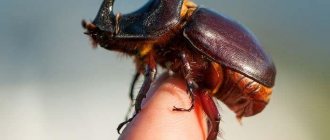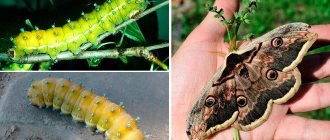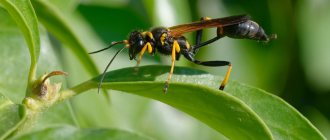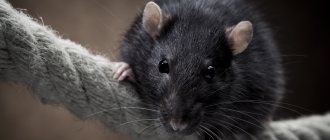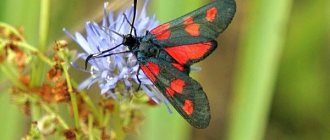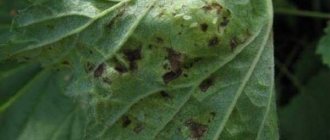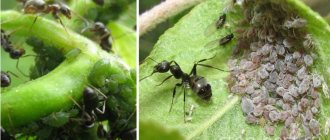Cutworms are unusual moths. How many varieties of cutworms exist in nature and what do they look like? Our photos and descriptions of the insect will tell you about this.
Cutworms or moths are a large family of lepidopteran insects. There are more than 35 thousand species of cutworms. There are about 1,800 species in Europe, and more than 1,500 species in Russia. Cutworms are found in various parts of the world. Any climate is suitable for their life. Cutworms thrive in deserts, mountains and tundra conditions.
Morphological characteristics of cutworm
Cutworms (Noctuidae).
The head of the moth is round, the forehead is characteristically convex; some individuals, on the contrary, have depressions on the forehead.
In females, the antennae have a simple structure, they are thread-like or comb-like, sometimes they can be framed by fluffy cilia. The structure of the antennae of males is more complex.
Noctuids living in the mountains have elliptical or kidney-shaped eyes. Some species have simple eyes. The proboscis is well developed; in a calm state it is curled. In some species the proboscis is reduced. The surface of the proboscis is covered with “taste cones”.
There are “bloodthirsty” exceptions among cutworms - individuals live in the tropics that feed on the lacrimal glands of mammals and their blood. Only males are bloodthirsty; they have a reinforced proboscis. Females have an undeveloped proboscis, so their diet is more “dietary”; they extract juice from fruits and plants.
Owls are nocturnal moths.
The palps of cutworms can be short or elongated. The head, chest and abdomen are often covered with scales and hairs. In addition, cutworms may have tufts of hairs.
Spurs are often located on the lower legs; other species have claws and spines. The shape of the wings is almost triangular, sometimes it can be elongated, and rarely rounded. Some species of moths have long and narrow wings; such wings allow butterflies to fly long distances. In mountain species, the wings are short, and sometimes they can be completely reduced.
Cutworm butterflies have a body covered with hairs.
The noctuid's body is full and covered with thick hairs. The wings have a pattern of spots; the spots are round, wedge-shaped and kidney-shaped. Some species have silvery and golden spots on their wings. The hind wings can be yellowish, blue, red and white. Noctuid moths, which live in climates with colorful nature, often have distinctive patterns on their wings and bodies.
Insect - black moth
Black moth is a fairly frequent guest in the house, and this insect can appear even in the cleanest room. It usually starts in cereals that have been stored for a long time.
Reproduction of such a pest occurs quickly, so it is very difficult to drive out individuals. However, if you use special drugs, you can cope with the scourge.
I got rid of MOLY once and for all! Housewife Irina Goncharova says: I just turn on Read more>>
Development of the scoop
There is a wide variety of cutworms, so the life cycle of different species varies greatly.
Caterpillars have up to 6 instars, during which up to 5 molts occur. Northern and mountain varieties generally have a two-year life cycle. Pupation of caterpillars occurs in earthen litter, soil or plant tissue. Mostly pupae overwinter, but middle-aged or older caterpillars can also overwinter. In warm areas, cutworms develop continuously, with several generations being formed per year. In winter, they go into a “cold stupor.”
The eggs are hemispherical in shape. The surface of the eggs is cellular or ribbed. Female cutworms lay eggs on the ground. The fertility of females can reach about 2 thousand eggs.
The moth butterfly family has many species.
The caterpillar has a naked body, but it may have primary setae and, in some cases, secondary setae. The body color of the caterpillars is green, yellow or brown. There are longitudinal stripes on the body. Sometimes false legs may be located on the abdominal segment. Noctuid caterpillars are active at night, and during the day they lead a hidden lifestyle. In some species, caterpillars are predators; they additionally feed on scale insects and scale insects.
People's Councils
Traditional recipes provide protection against re-infection and prevent the insect from settling. The black moth is a butterfly with a keen sense of smell. In this way, she finds a mate and favorable places for the development of larvae. Strong smells confuse her, and staying in such a room becomes difficult. A black moth can fly into a house, but it won’t want to stay. Interestingly, certain smells definitely affect her.
- Tobacco. You can use cigarettes with a rich smell.
- Orange or tangerine peels.
- Lavender. Both the plant itself and the essential oil are used. Oils are added to water to wipe the cabinet or applied to cotton wool.
- Garlic. The slices are laid out in the corners of the cabinet.
- Fresh toilet soap with a strong scent.
- Vinegar. Add to water during cleaning.
Protection lasts as long as the smell is present. As it weakens, it needs to be renewed. It is also recommended to alternate products. Because black moths can get used to them.
For preventative purposes, cabinets should be cleaned and the backfill should be stored in sealed containers. Check cereals in the store for caterpillars. Avoid spilled grains.
exclamation scoop
These pests spoil potatoes, onions, carrots, peas, corn, beets, lettuce, turnips, sunflowers and strawberries. They destroy tubers and roots, after which the plants die.
Some of the cutworm butterflies harm plants.
Cutworm larvae spend most of their time in the ground, but may feed on leaves above. The wing span of an adult moth is 30-40 millimeters. Color varies from dark brown to light gray.
Ways to fight
Black moths often appear in food products:
Various foods suffer from the caterpillar, but most often dried fruits and cereals
First, you should conduct an inventory audit. Then the products need to be transferred to resealable jars or plastic bags, but they should be well tied.
If food is heavily soiled, it should be thrown away. Eating such food is dangerous. If black moths have just begun to infect cereals, get rid of the source of infection.
You may also be interested in the article in which we talk about the preferences and methods of detecting moth larvae.
Stem cutworm
These cutworms damage cereal crops. Stem cutworms live in the steppe zone of Siberia. These pests cause damage to rye, wheat, corn and oats.
Noctuid moths of this species reach a length of 38 millimeters. The wings are yellowish-white, with a light stripe running down the center. The pupae are black and brown in color and are 15 millimeters long.
Cutworm caterpillars gnaw at the base of stems, settle inside the stem and suck out plant juices. Because of such pestilence, the plants dry out and the ears do not ripen.
The flight of stem cutworms takes place in June-July. Females lay medium-sized eggs, in an oviposition their number reaches 130 pieces. One generation of stem cutworm develops in one season.
How to get rid of moths (video)
Moths can appear even in a clean room. It causes a lot of inconvenience, for example, it spoils food. The main threat comes from larvae and females. Males simply fly around the room; they do not lay eggs. Often insect caterpillars spoil seasonings, dried fruits, and cereals. If trouble occurs, spoiled products should be disposed of. Disinfection of shelves and corners is also necessary. You can use chemical control methods - tablets and sections. They are simply laid out on shelves. Among folk remedies, it is better to use herbs and oils with a pungent odor. They give a good effect.
Pea cutworm
These pests cause damage to legumes and grain crops. They live in many areas. Pea cutworms parasitize peas, alfalfa, clover, sugar beets and legumes.
Some cutworms feed on animal blood.
The butterfly measures no more than 42 millimeters. The front wings are black-brown in color. There are transverse lines on the wings. The caterpillars are yellow in color, the body size of the caterpillars reaches 4 millimeters.
Flight of pea cutworms takes place in June-September. These butterflies feed on succulent plants. One female lays up to 400 eggs. Caterpillars eat leaves. 2 generations develop per year.
Preventive measures
- To prevent harmful moth larvae from appearing indoors, you should keep food in metal or glass containers with tightly closed lids. You can place walnut leaves, garlic, and orange peels on the shelves.
- It is recommended to place various traps in the kitchen. They are sold in stores. The triangular boxes contain a sticky substance inside. The principle of action is pheromones that attract parasites. They place traps directly on the shelves in the closet. Even if all the pests are gone, it is recommended to leave the traps.
- You should not keep too many cereals in your apartment. If you bought something at the store, put it in the freezer for a couple of hours. You can simply store cereals in the freezer.
- You should also thoroughly clean all cabinets every 30 days.
To prevent harmful moth larvae from appearing indoors, you should keep food in metal or glass containers with tightly closed lids.
Sage cutworm
These butterflies are pests of essential oil crops. Sage cutworms are found wherever there is sage, lavender, mint, and other similar crops.
The wingspan of the butterfly reaches 40 millimeters. The front wings are yellow-gray, the hind wings are lighter.
The flight of these butterflies takes place in April-July. The fertility of females is up to 600 eggs. Caterpillars damage leaves, ovaries, buds and pedicels. They begin to damage plants from top to bottom. 3 generations develop in a year.
Methods to combat black moths
First, you need to check all products and supplies. After this, they need to be transferred to jars that close tightly and plastic bags that can be tied.
If food is too contaminated, it is best to simply throw it away.
Eating it is dangerous for humans. If moths have just begun to appear and infect cereals, then the source of infection should be disposed of immediately.
Lumps need to be removed from the web. Then dry the food in the oven or microwave. Simply pour it onto a baking sheet and dry it in the oven for 20 minutes with the door open. Then place the cereal in a sealed container.
The last stage is disinfection of all shelves in the apartment.
You need to dissolve the soap in water and treat all surfaces with this composition. Then the procedure must be repeated, but only using ordinary water. All cracks must be wiped with vinegar. Before filling the cabinets after this treatment, you need to wait a couple of hours until they dry.
Various chemicals in the form of plates, tablets, sections, briquettes and aerosols will help you deal with black moths in your apartment. The cheapest options are briquettes, plates and tablets. They contain naphthalene and camphor. Products should be placed on the top shelves. Pairs of active compounds go downwards, which prevents the process of moth reproduction. The impact period is approximately six months. The technique is considered effective, but not entirely safe for humans. Before using the tablets, they must be wrapped in gauze. For more information about getting rid of insects, watch this video:
With the help of special sections, fighting black moths is quite simple. However, you must first read the instructions. For a room of 15 square meters. m. you will only need 1 section. It should be located away from children, animals and food.
First you need to remove the tape, then put the sections in the upper corners of the cabinets.
You can choose any scent: tangerine, lavender, chamomile. The section is valid for six months. Then the device needs to be changed. Be sure to follow the instructions to prevent poisoning.
OUR READERS RECOMMEND! In the fight against moths, our readers recommend the Pest-Reject repeller. Electromagnetic and ultrasonic technology is 100% effective against cockroaches and other insects. Absolutely safe, environmentally friendly product for humans and pets. Read more here.
Yellow-brown early armyworm
This type of cutworm is especially harmful to fruit crops. Early cutworms live almost throughout the entire territory of Russia. Pests damage raspberries, apple trees, cherries, pears, plums, peach and various forest species.
Butterflies reach 35 millimeters in length. The color of the front wings is yellowish with a white stripe, the hind wings have a fringe. The body length of the caterpillars reaches 40 millimeters, and the pupa – 15 millimeters.
Scoop Gamma.
Females of early cutworms lay up to 900 eggs. The caterpillars of these cutworms destroy ovaries and leaves.
Where does it appear in the house?
A black moth may appear in an apartment by accident. Enters through an open window and then looks around. People themselves bring it into the house along with cereal from the store. There may not be worms in the package at the time of purchase. But after a while, butterflies begin to flutter around the kitchen. And the packaging will be filled with caterpillars and moths. Contamination may occur during storage. The pest gets into the packaging due to the negligence of the workshop workers. And under favorable conditions it begins to actively develop. In addition, it may appear from neighbors through ventilation, sewerage and other paths.
The main danger lies in the fact that black moths reproduce very quickly. In room conditions, it will ruin all supplies in 1–2 months.
Scoop gamma
These pests are polyphagous. They are widespread in Russia everywhere. Gamma armyworms damage field crops such as beets, potatoes, flax, hemp, legumes and the like.
Butterflies measure up to 48 millimeters. The front wings can be purple to gray in color and have a “gamma” shaped spot on them, hence the name. These cutworms fly during the day and feed on flower nectar. One female brings 500-1500 eggs. Over the course of a year, 2 generations of gamma scoops can develop.
Why are they dangerous for humans?
Adults feed exclusively on flower nectar; large butterflies have the same diet. Night moths do not cause any harm to agricultural land or to humans personally. But the caterpillars eat herbaceous plants, which can have a detrimental effect on the quantity of the harvest and its quality. That is why butterflies of all sizes and colors are often disliked by farmers.
Butterfly
The imago cannot cause harm to humans, but some types of caterpillars secrete toxic substances that, if they come into contact with the skin, can cause allergic reactions of varying complexity.
Important!
You should never touch the caterpillar with unprotected hands.
Origin of the species and description
Photo: Hawk Moth Butterfly
The hawk moth butterfly is an arthropod insect, classified in the order Lepidoptera, the hawk moth family. The name of one of the most famous subspecies of the hawkmoth subspecies is death's head. This is explained by the fact that on the outer surface of the head there is an image resembling the shape of a skull. This butterfly is the hero of many mythical tales and beliefs.
The scientist Heinrich Prell studied the species and described it in the 20th century. This type of insect has always aroused unprecedented interest. In ancient times, these butterflies were considered messengers of misfortune and signs of failure and disease. People believed that if this insect suddenly entered a human home, then death would soon come here. There was also such a sign: if a piece of a wing gets into the eye, then the person will soon go blind and lose his sight.
Video: Butterfly Hawkmoth
In zoological atlases, the hawk moth butterfly is found under the name Acherontia atropos. Translated from Latin, the name of this butterfly symbolizes the name of one of the water sources of the kingdom of the dead. Initially, zoologists believed that butterflies appeared on earth after the appearance of flowering plants. However, this theory was not subsequently confirmed. Establishing the exact period of appearance of butterflies on earth is problematic. This is due to the fact that Lepidoptera have a fragile body.
Findings of the remains of ancient ancestors of modern butterflies are very rare. They were mainly found in pieces of resin or amber. The most ancient finds of the ancient ancestors of modern Lepidoptera date back to 140-180 million years ago. However, scientists claim that the first primitive butterflies, resembling moths in appearance, appeared on earth a little over 280 million years ago. This type of butterfly is divided into a huge number of subspecies, each of which has its own distinctive characteristics.
Other butterflies of the Red Book
Moltrecht ribbon
(
Catocala moltrechti
)
Lucina
(
Hamearis lucina
)
Mongolian bear
(
Palearctia mongolica
)
Solitary bear
(
Camptoloma interiorata
)
Mimeusemia is similar
(
Mimeusemia persimilis
)
Mnemosyne
(
Parnassius mnemosyne
)
Mother of pearl zenobia
(
Argynnis zenobia
)
Shokiya is exceptional
(
Seokia eximia
)
Sericin Montela
(
Sericinus montela
)
Sphecodina caudate
(
Sphecodina caudata
)
Raphael's tail
(
Coreana raphaelis
)
Wild mulberry silkworm
(Bombyx mandarina)
Erebia Kindermann
(
Erebia kindermanni
)
The Prince of Darkness is one of the most beautiful butterflies in the world
The large butterfly Prince of Darkness is considered an excellent representative of the largest and most dazzling insects. The subspecies of this butterfly includes the Emperor, which attracts special attention with its bright colors. Unfortunately, like many butterfly species, the Prince of Darkness lives only ten days. The wings of a beautiful butterfly resemble a snake's head, and therefore such camouflage saves the butterfly from many hunters.
